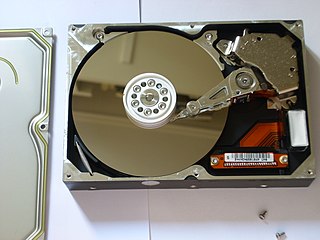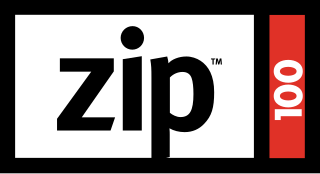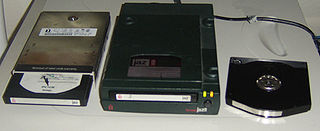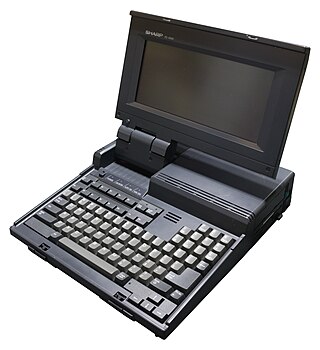
A hard disk drive platter or hard disk is the circular magnetic disk on which digital data is stored in a hard disk drive. The rigid nature of the platters is what gives them their name. Hard drives typically have several platters which are mounted on the same spindle. A platter can store information on both sides, typically requiring two recording heads per platter, one per surface.

The Zip drive is a removable floppy disk storage system that was announced by Iomega in 1994 and began shipping in March 1995. Considered medium-to-high-capacity at the time of its release, Zip disks were originally launched with capacities of 100 MB, then 250 MB, and finally 750 MB.

Floptical refers to a type of floppy disk drive that combines magnetic and optical technologies to store data on media similar to standard 3+1⁄2-inch floppy disks. The name is a portmanteau of the words "floppy" and "optical". It refers specifically to one brand of drive and disk system, but is also used more generically to refer to any system using similar techniques.

The Jaz drive is a removable hard disk storage system sold by the Iomega company from 1995 to 2002.

The LTE is a line of laptops manufactured by Compaq Computer Corporation, introduced in 1989 and discontinued in 1997. It was the first notebook-sized laptop sold by Compaq and the first commercially successful notebook computer, helping launch the burgeoning industry.

Travelstar was a brand of 2.5-inch hard disk drive (HDD) that was introduced by IBM in 1994 with the announcement of the Travelstar LP. At 12.5 mm high with two platters, they were available in 360, 540 and 720 MB capacities. Initial models were industry-leading for small form factor HDDs in terms of areal density, data transfer rates and shock tolerance (500g).

In 1953, IBM recognized the immediate application for what it termed a "Random Access File" having high capacity and rapid random access at a relatively low cost. After considering technologies such as wire matrices, rod arrays, drums, drum arrays, etc., the engineers at IBM's San Jose California laboratory invented the hard disk drive. The disk drive created a new level in the computer data hierarchy, then termed Random Access Storage but today known as secondary storage, less expensive and slower than main memory but faster and more expensive than tape drives.

Irwin Magnetic Systems, Inc., also known as Irwin Magnetics, was a computer storage manufacturer active from 1979 to 1989 and based in Ann Arbor, Michigan. It was founded by Samuel Irwin in 1979 as Irwin International, Inc. The company's primary export was magnetic tape data storage and backup systems for personal computers. Irwin was one of the first companies to manufacture quarter-inch cartridge (QIC) systems for the personal computer market. In 1989, the company was acquired by Cipher Data Products.

The history of laptops describes the efforts, begun in the 1970s, to build small, portable Personal Computers that combine the components, inputs, outputs and capabilities of a Desktop Computer in a small chassis.

The floppy disk is a data storage and transfer medium that was ubiquitous from the mid-1970s well into the 2000s. Besides the 3½-inch and 5¼-inch formats used in IBM PC compatible systems, or the 8-inch format that preceded them, many proprietary floppy disk formats were developed, either using a different disk design or special layout and encoding methods for the data held on the disk.
The PB286LP, released in 1989, was Packard Bell's first laptop computer. The laptop featured an 80C286 processor clocked at 12 MHz and 1 MB of RAM, along with a single ISA expansion slot. Packard Bell released the PB286LP in 1989 among a slew of products aimed at the corporate market. Technology writers gave it mostly positive reviews, although some noted its 16-lb weight as hefty and its monochrome LCD as somewhat flawed. Originally only capable of CGA-mode graphics, the laptop was updated in 1990 to support VGA. Packard Bell discontinued the PB286LP in 1991, in favor of more-compact, notebook-sized computers.

The Sharp PC-4500 is a line of laptop computers released by Sharp Corporation in 1987. The line comprises the PC-4501, the PC-4502, and the PC-4521. The PC-4501 is a bare-bones unit with only 256 KB of RAM stock, only one floppy drive, no backlighting, and no built-in numeric keypad; the PC-4502 and PC-4521 bumps the stock RAM to 640 KB and includes the latter two features while providing either two floppy drive (PC-4502) or one floppy drive and a 20 MB hard drive (PC-4521). Prices on the line initially ranged from $1,295 to just under $3,000; the PC-4501 was later sold for $995, becoming one of the first sub-$1,000 laptops available on the market. The PC-4500 line received mixed, mostly positive, reviews on its release in September 1987.

The SupersPort is a line of PC-compatible laptops manufactured by Zenith Data Systems and sold from 1988 to 1993. The first two main entries in the SupersPort line included either an Intel 80286 microprocessor clocked at 12 MHz or an 8088 processor clocked at 8 or 4.77 MHz, switchable. Later entries included the 386SX, 486SX and 486 processors. The SupersPort 286 in particular was one of the top-selling laptops of the late 1980s, although Zenith's position in this segment faltered by the early 1990s.

Colorado Memory Systems, Inc. (CMS), was an American technology company independently active from 1985 to 1992 and based in Loveland, Colorado. The company primarily manufactured tape drive systems, especially those using quarter-inch cartridges (QIC)s, for personal computers and workstations. Colorado Memory Systems was founded by Bill Beierwaltes as an offshoot of his previous company, Colorado Time Systems, also based in Loveland. It was acquired by Hewlett-Packard in 1992.

The LTE, LTE/286, and LTE/386s were a series of notebook-sized laptops manufactured by Compaq from 1989 to 1992. The three laptops comprise the first generation of the LTE line, which was Compaq's second attempt at a laptop following the SLT in 1988 and their first attempt at a truly lightweight portable computer. The LTE line proved highly popular—Compaq selling hundreds of thousands of units between the three—and gave way to successive generations of the line, including the LTE Lite, the LTE Elite, and the LTE 5000 series. With its use of industry-standard floppy and hard drive technologies, the LTE was the first commercially successful notebook computer and helped launch the fledgling notebook industry, which had seen earlier attempts fail due to the use of novel but nonstandard data storage.
Areal Technology, Inc., was an American hard disk drive manufacturer active from 1987 to 1999. The company was the first to produce hard drives employing glass as the substrate for their platters, allowing for significantly higher data densities and greater shock resistance. Other hard drives manufacturers across the board soon followed suit with this approach. In 1993, Areal was sold to Tomen Electronics and Sanyo, who operated the company as a joint venture. Areal continued as a subsidiary until 1999.

Jonos International, Inc., originally Jonos, Ltd. (JL), later Netcom Research, Inc., was an American computer company active from 1980 to 1992. The company sold a variety of computer hardware products and systems, including STD Bus peripherals, smart terminals, microcomputers, and portable computers. The company's Courier portable computer was the first microcomputer sold with Sony's then-new 3.5-inch floppy disk drives on its release in June 1982. Jonos' systems were widely used in the fields of construction, roadworks, machining, and military.

Intégral Peripherals, Inc., or simply Intégral, was an American computer hardware company based in Boulder, Colorado, and active from 1990 to 1998. It was the first company to manufacture hard disk drives with a platter diameter of 1.8 inches, smaller than the typical 2.5-inch hard drives used in laptops and other mobile devices. Initially met with market skepticism, Intégral found success in the mid-1990s with design wins in products by IBM, Hewlett-Packard, and Toshiba, among others. However, its investors dropping out of the company amid the 1997 Asian financial crisis caused the company to file bankruptcy in 1998, after which it was acquired by private equity firm H&Q Asia Pacific.
MiniStor Peripherals, Inc., was a public American computer hardware company based in San Jose, California, and active from 1991 to 1995. The company was the first to manufacture and market PC Card spinning hard drives, based on the 1.8-inch hard drive specification invented earlier by Intégral. The company briefly rode a wave of success in this market before dissolving amid bankruptcy proceedings in April 1995.















